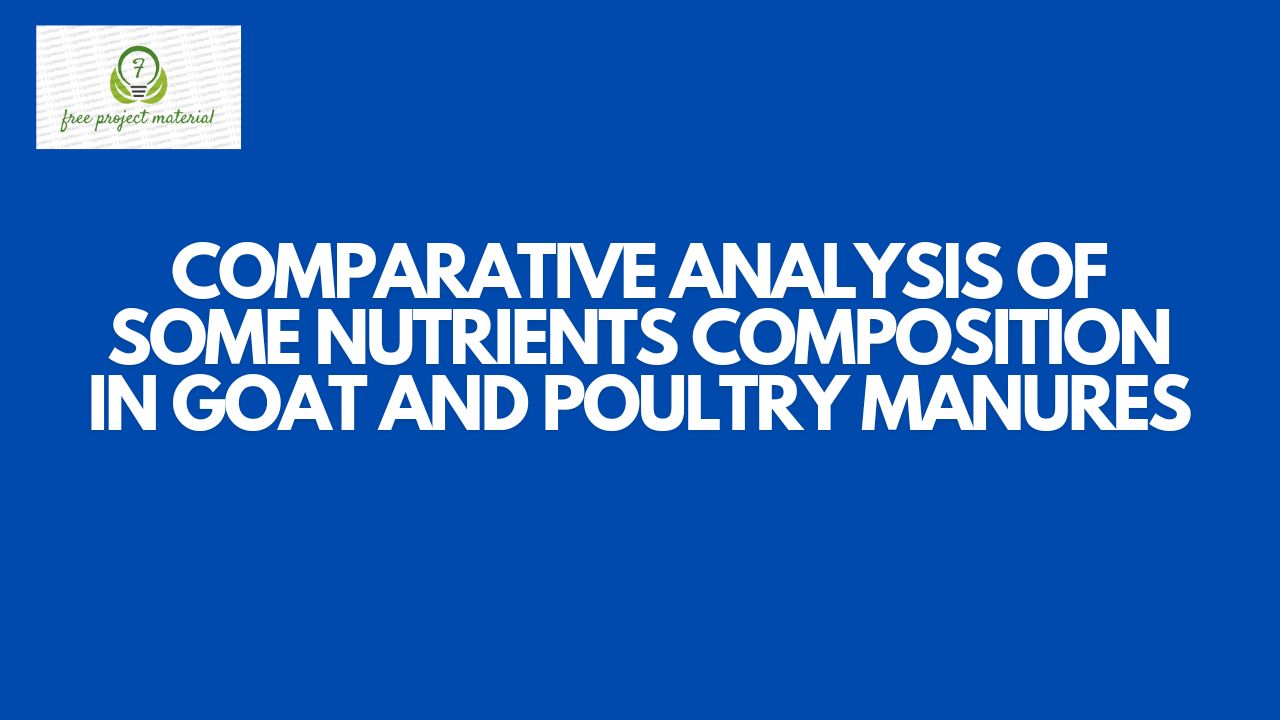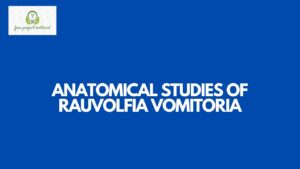ABSTRACT
This study on comparative analysis of some nutrient composition in goat and poultry manures was carried out using standard analytical methods. The results of the study revealed the following; phosphorus, calcium and magnesium in poultry manure were 2314.00, 1490.21 and 2671.81 mg/kg while the corresponding values of 1591.00, 1101.96 and 2321.09 mg/kg were obtained from Goat manure. The sodium, potassium, iron, manganese and copper contents recorded 2381.66, 5922.64, 146.71, 53.41 and 47.82 mg/kg for poultry manure compared to the corresponding amounts of 1217.92, 4741.66, 200.63, 68.41 and 81.66 mg/kg obtained for goat manure. It concluded that the nutrients composition in poultry manure is higher than that of goat manure. However, both manures should be used in improving soil fertility.
TABLE OF CONTENTS
Title Page – – – – – – – – i
Certification – – – – – – – – ii
Dedication – – – – – – – – iii
Acknowledgements – – – – – – iv
Abstracts – – – – – – – – v
Table of Contents – – – – – – – vi
CHAPTER ONE: INTRODUCTION
1.1 Background of the Study – – – – – 1
1.2 Aim and Objectives of the Study – – – – 3
1.3 Scope and Limitation of the Study – – – – 4
CHAPTER TWO: LITERATURE REVIEW
2.1 Manure – – – – – – – – 5
2.2 Types of Manure – – – – – – – 5
2.2.1 Animal Manure – – – – – – – 5
2.2.1.1 Sheep and Goat Manure – – – – – – 7
2.2.1.2 Poultry Manure – – – – – – – 7
2.2.2 Green Manure – – – – – – – 7
2.2.3 Vermi Culture – – – – – – – 9
2.2.4 Concentrate Organic Manure – – – – – 10
2.3 Benefit of Organic Manure – – – – – 11
2.4 Plant Nutrients – – – – – – – 14
2.4.1 Nitrogen – – – – – – – – 14
2.4.2 Phosphorus – – – – – – – – 15
2.4.3 Potassium – – – – – – – – 16
2.4.4 Chloride – – – – – – – – 18
2.4.5 Boron – – – – – – – – – 18
CHAPTER THREE: MATERIALS AND METHODS
3.1 Materials – – – – – – – – 20
3.1.1 Source of Sample Collection – – – – – 20
3.2 Laboratory Preparation of Sample – – – – 20
3.2.1 Digestion of Sample – – – – – – 21
CHAPTER FOUR: RESULTS AND DISCUSSION
4.1 Results – – – – – – – – 22
4.2 Discussion – – – – – – – – 24
CHAPTER FIVE: CONCLUSION AND RECOMMENDATIONS
5.1 Conclusion – – – – – – – – 28
5.2 Recommendations – – – – – – – 29
References
CHAPTER ONE: INTRODUCTION
1.1 Background of the Study
Manure is organic matter which is prepared by rotting animal dung, crop residues, peels of fruits and vegetables etc. After decomposition, they provide a wide range of nutrients to the plants. It is the most natural and chemical free substance to increase the yield of crops and to improve the production efficiency of the soil. The methods of this preparation are very old and popular among farmers. Today, where earlier farmers were use chemical fertilizers to increase the maximum production of their crops, but now they giving more importance to natural fertilizers than chemical fertilizers. In this generation, chemical fertilizers have so much adversely effected on the land that the yield of the crop has increased but the outbreak of diseases and pests has increased in the cereals, that is why most of the farmers have now turned towards natural fertilizers instead of chemical fertilizers (TNAU, 2016).
Some scientists did research on a mixture of chemical and organic fertilizers. It assessed the integrated effect of poultry manure (PM) and cattle manure (CM) with (CF) i.e. urea on soil properties, plant physiology and rice grain yield. Thus, (PM) or (CM) i.e. poultry manure with 70% N from CF i.e. urea and Combination of 30% N from cattle manure is a promising alternative for improving soil quality and rice grain yield. Furthermore, our study provides a sustainable nutrient management plan to increase rice yield with high N use efficiency (Iqbal, et. al.2020).
Instead of chemical fertilizers with high nutrients, low nutrient fertilizers improve the physico-chemical and biological properties of the soil, no special type of material is required for its preparation and their effect also remains for a long time. It contains naturally occurring synthetic chemicals and nutrients.
Organic manures are organic residues of animal and plant by-products (Hoover et al., 2019) and (Ryne et al., 2020). Small scale farmers usually rely on organic manures due to high costs and less accessibility of inorganic manures (Sanyoolu et al., 2018) and (Yam et al., 2021), which includes animal manures, compost, and green manures (Ekwealor et al., 2020). Organic manures improve plant root rizoster conditions which assimilation of nutrients from the soil (Sari et al., 2019), as well as the nutrient content of the plant itself (Ayinla et al., 2018; Adekiya et al., 2020). Applications of 2.5–6 t ha–1 poultry manure cause an increase in the Ca, Mg (Akande et al., 2011), ash, fats, N, P, and protein contents in S. indicum leaves (Anguria et al., 2017). The increase in the ash, fat, and protein content was also noted in Amaranthus caudatus and A. cruentus when poultry manure was applied (Kahu et al., 2017). Further, there is an increase in proximate and mineral contents with the application of 0.03 t ha–1 of poultry manure on A. cruentus, A. hydridus, A. deflexus, and A. spinosus (Oyedeji et al., 2014). Goat manure applied at rates ranging from 2.5–13 t ha–1 resulted in an increase in Ca, Mg, N, P, and K content in Capsicum annuum leaves (Awodun et al., 2007). Application of 8 t ha–1 goat manure increases Ca, Cu, Fe, K, Mg, Mn, Na, P, and Zn content in Cleome gynandra shoots (Sownnmi et al., 2015).
1.2 Aim and Objectives of the Study
The aims of this research therefore include:
- To compare the nutritional composition in some poultry manure and goat manure.
- To therefore make necessary recommendation base on the result of this work.
- To compare this study with the previous study
1.3 Scope and Limitation of the Study
This research work only covers on the nutritional composition in goat and poultry manure. This is due to time and financial constraints.


